Visit to the domes of the churches of Quito

SOLEQMASTER
Get to know the city of Quito from above.
The other day our agency, SOLEQ.travel, was invited by the metropolitan public company of Quito Tourism Destination Management to get to know one of the secrets of the city of Quito. This time I was the one who joined a group of 8 people on this tour where we visited the domes and towers of the most emblematic churches in the historic center of Quito. During the day we visited places only few people know about that you can access.
Church of the Basilica del Voto Nacional.
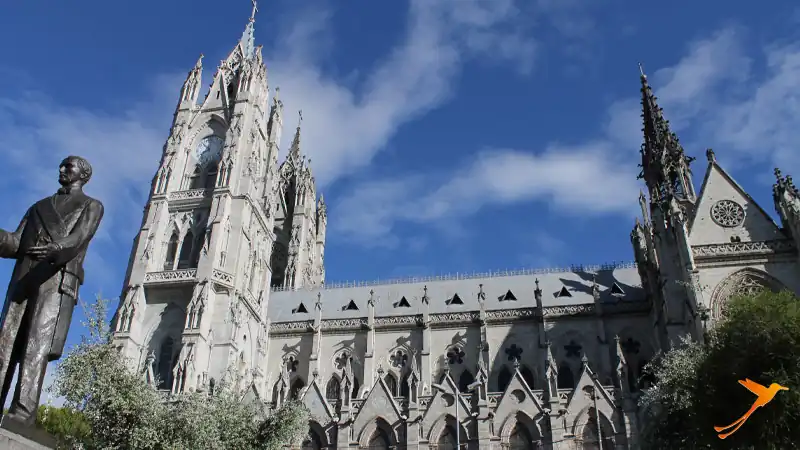
We walked through the historic center of Quito, starting at the Basilica del Voto Nacional church. This is the largest neo-gothic temple in Latin America. Once we passed the entrance we went up on the left side until we reached the store where they sell souvenirs. We passed by the store and went upstairs to a beautiful place where we were able to admire the main aisle of the church and in the distance the main altar, to the north. To the south we saw one of the most elegant windows of this church adorned with colors and ornaments of Ecuadorian roses, which represent the woman and therefore the Virgin.
On the next floor we found: to the south the first viewpoint with its balcony overlooking the southern part of the city and to the north a tunnel with a narrow path, which is like a wooden bridge. It felt strange since you are right on the roof of the church. At the end of the tunnel there is a staircase that leads to another viewpoint located in the back tower, from where you can see the city. From here there is another iron staircase that leads to the top of the tower. It is called the viewpoint of the condors and for me it has one of the best 360° views of Quito.
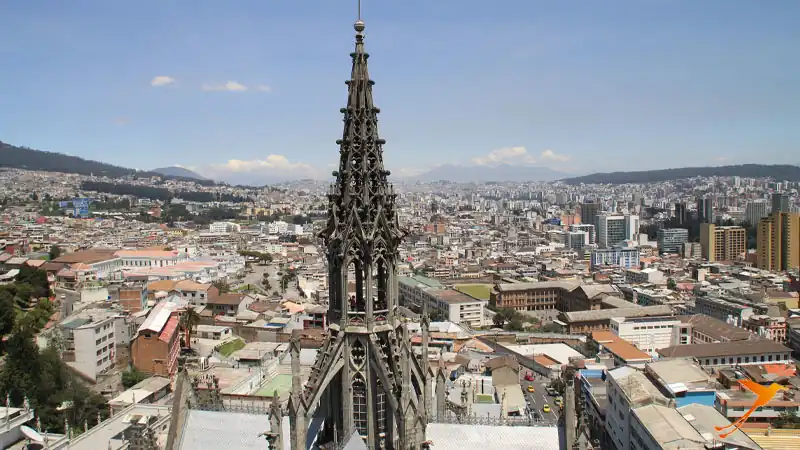
Heading out, we decided to enter through the door located on the east side to take a look at the main nave. During the visit, the guide explained to us that from the main altar you can see the statue of the Virgin of the Pancillo, right in the window or light swallower in the shape of a heart located at the top of the main door. We were able to see it immediately since the statue of the virgin looks directly towards the church. The statue is supposed to take care of the heart of Jesus.
For the history we must thank Father Julio Matovelle, from the Oblate congregation located in the city of Cuenca, who was also the mentor who commissioned the elaboration of the statue with the architect Agustín de la Herrán Matorras.
As you leave the church you can find animals of the Ecuadorian fauna, such as birds, crocodiles, monkeys, iguanas, turtles, armadillos, adorning the exterior of the church. For me personally, it is one of the most beautiful churches that are part of the patrimony of the churches of Ecuador. Next up, the church of Santa Bárbara.
Voto Nacional Church.
Address: between Calles Carchi N122 y Venezuela.
Construction: XIX Century
Visiting hours: every day from 9:00 a.m. to 5:00 p.m.
Church of Santa Bárbara
We continued the tour of the churches of Quito. For this occasion, we were allowed to enter the church of Santa Barbara. I was impressed by the blue and lead colors of the convent’s habit of the nun. She later informed us that she is part of the order Servant of the Lord of the Incarnate Word. She was the one who led us inside the church. On the main altar you can see the sculpture of Saint Barbara, of whom we were told that she was a “martyr” in her life. In other words, she was persecuted for a great part of her life and in the end she died defending her cause.
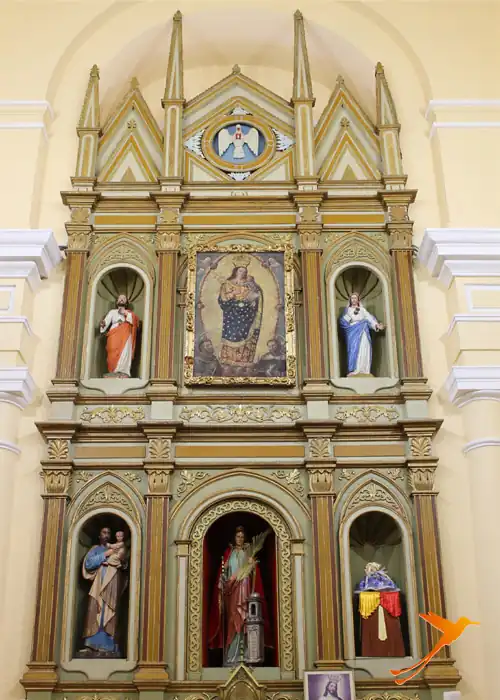
The sculpture carries a palm leaf in her left hand and in her right hand she holds a sword. Alongside is a tower that represents the castle where she lived, the guide also told us that this is where she was locked up by her father because she did not share the same beliefs with him. It even went so far that he himself killed her with this sword and God immediately punished him by sending a lightning bolt that fulminated him. Therefore, it is common belief to pray to Santa Barbara when it rains hard in the city, even with lightning. They say: Blessed Saint Barbara, protect us from storms, lightning and thunder. Another thing to point out is that on the south side of the interior, as part of its structure, there is a Greek cross and on the right side, there is a picture of the Virgin of the Spike, who represents it and who gives us food.
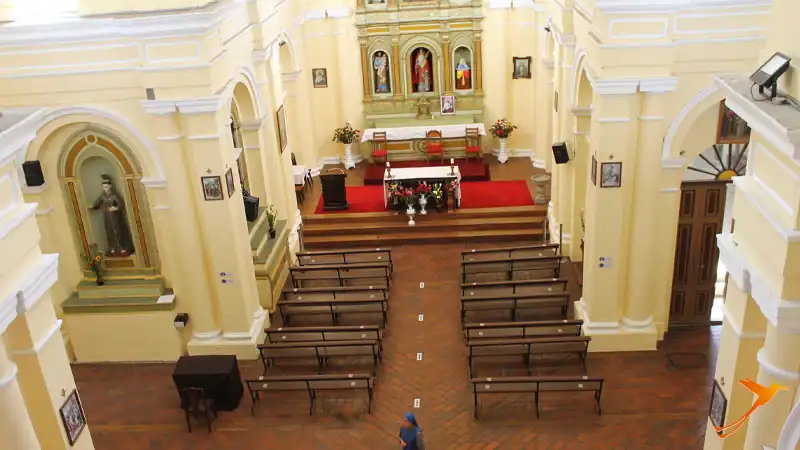
The first church that was built here dates back to the XVII century of which only the stone foundations remain. It is considered to be of Neo-classical style. In Santa Barbara the first cross was built, and it is where the street known today as Calle de las 7 cruces begins from north to south. On the street corner is one of the first water fountains that formerly supplied the vital liquid to the nearby neighborhoods.
But the adventure had just begun, through the back of the church we went up to the choir from where we could access the domes through a window. We left our bags and backpacks, one by one walked across a short metal bridge suspended in the air from where the stairs start. The stairs are made of iron protection and lead us to the roof of the church and from here you can access one of the domes. The view from here is phenomenal. You can see the city of Quito with a 360° view. It is recommended that people who are afraid of heights or are overweight should not attempt it.
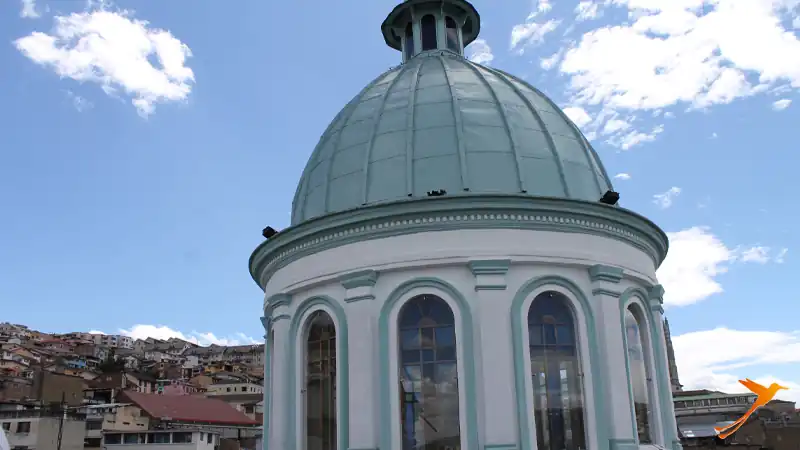
Santa Barbara Church
Address: Calle García Moreno
Construction: XVI Century
Visiting hours: Reservations required
Church and convent of Santo Domingo
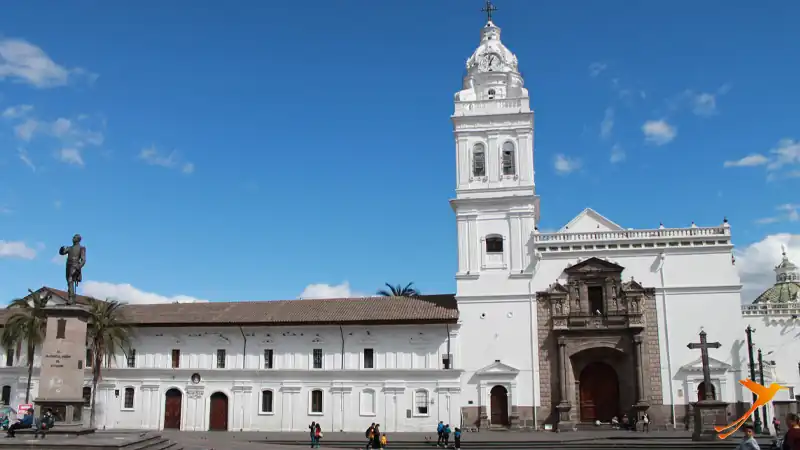
We continued through the historic center of Quito. We walked across the Plaza de Santo Domingo, passing by the statue of Mariscal Antonio José de Sucre, and entered through the door of the art museum, in honor of the friar Pedro Bedón. Once inside we found ourselves in the hall of the inner courtyard with its stone basin in the center. Then we went to the refectory, a place where the Dominican fathers used to serve their meals.

We walked through a wooden door lined with a stone arch from floor to ceiling. Inside we were struck by how well maintained the ceiling and walls of this room are, with many works of art and pictures of saints who were martyrs. Most of them are of Mudejar art. It is called refectory because of the natural light that enters through the windows of this room.
Next we continued walking around the courtyard. We were impressed by the wooden decorations with more works of art.
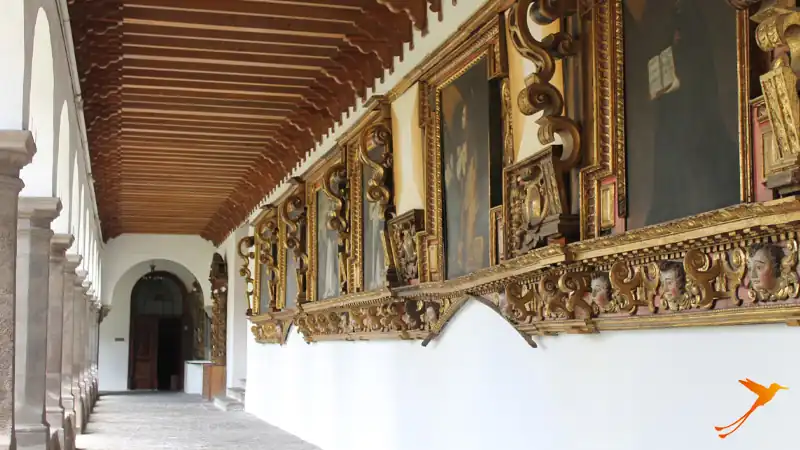
As we walked through the hall we made a stop to see the floor through a glass. Here you can see how the bases or foundations of the complex were established. Then in one of its corners we went up to the upper floor where we found more works of art and well-preserved wooden furniture. We entered through a small door that took us to the back-top of the church; it is a spectacular view where you can see how big the main nave is and you can even see the main altar. Baroque style. In the interior of the church we noticed that it is of Spanish Arab style. The church has a small corridor that takes you to a door you must go through to go up some steep stairs.
Finally, we went out to the roof of the church from where we were able to appreciate the domes. From there we could enjoy a postcard view of the south of Quito, the Panecillo, Rocafuerte street and even the street known as “Mama Cuchara”. It is recommended to walk along this terrace, slowly and carefully, then you can also walk around the domes and even climb one of them. We were on the outside of the chapels of the Virgin of the Rosary and the Virgin of the stairs. This is an ideal place to take pictures and selfies, and as a reference point we are sitting right on top of the Arch of Santo Domingo.
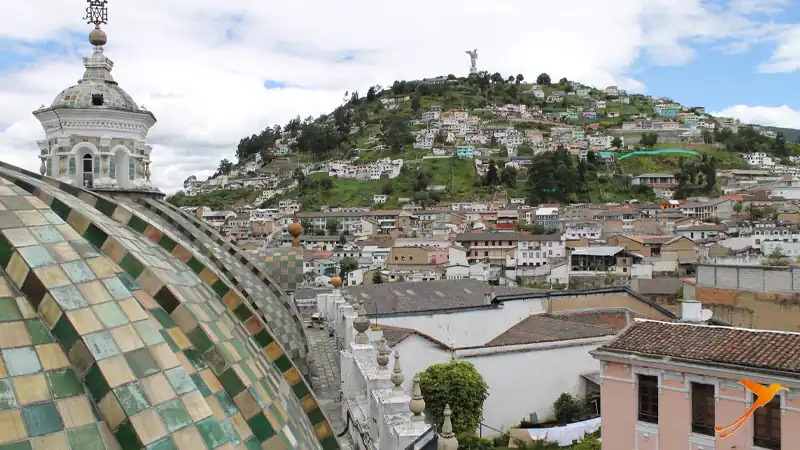
Church and convent of Santo Domingo
Museum: Fray Pedro Bedón
Address: Calle Flores 150 y Bolívar
Construction: XVII Century
Visiting hours: M to F 9:00 to 13:00 and 14:00 to 16:30 Saturday 9:00 to 13:00
Lunch at the San Agustin Ice Cream Parlor.
At 2:00 p.m. lunch was organized in one of the 17 buildings of the XVII century. What this wonderful Quito has to offer. On this occasion we enjoyed a delicious lunch at the San Agustin ice cream parlor. Famous for its typical ice cream in the city of Quito.
The Compañía de Jesús
We continued walking through the main square towards one of the most visited churches by national and foreign tourists. This church is also used by the president of Ecuador to welcome important visitors and even the mayor of the city uses this place to give the key to the city of Quito as a present. One of the peculiarities of La Compañía de Jesús is the splendor of the gold leaf that covers almost the entire interior.
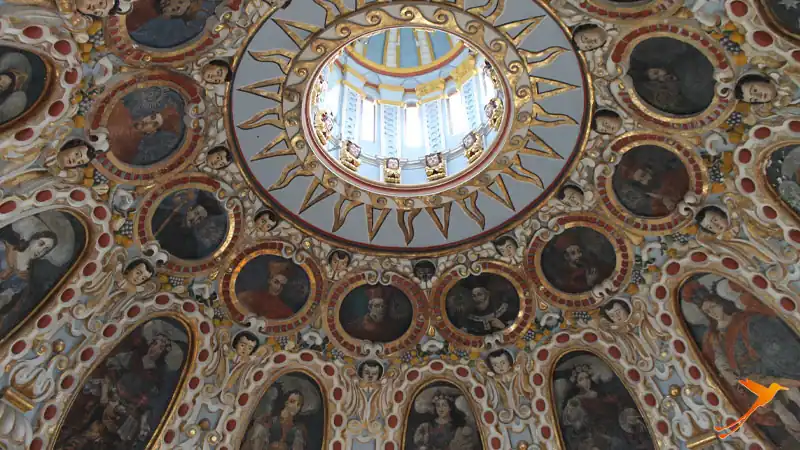
We continued along the right side and after passing by the tombs then by the photographs of the domes and the bells, we climbed the stairs leading to the outer courtyard. From there we went through the hall that leads to a small door and through it to some steps to the top floor. (Photo Quito tourism).
The access is the most comfortable compared to the other churches in Quito that we mention in this document. As we climbed up the stairs we heard the creaking of the wood of the old stairs. Finally we stepped outside and were able to see one of the best views of the facade of the church and convent of the church of San Francisco on our right. We found ourselves on a fairly large terrace, which also has a 360 ° view of the entire historic center of Quito.
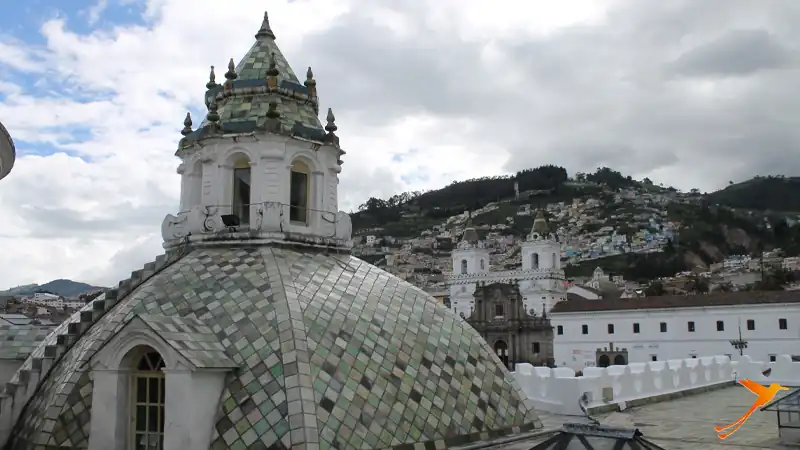
To the left you can see the domes which can be entered. Entering through a door-window you will be walking right on top of one of the domes, it is really fascinating to see the view from here. This part is a narrow path around the dome, if you raise your hand you can almost touch the angels that are part of this extraordinary work of art and especially the angel that keeps its black face because it carbonized as a result of the smut that affected it by the fire years ago. Restorers decided not to touch it just for people to appreciate the degree of affectation that had all this dome. From here you can see that as a precaution, they placed a mesh to avoid falling objects from affecting or damaging the people below.
On the way back to the outer courtyard, we walked through the offices of the foundation of the church. There are paintings of the old city of Quito in one of the halls, where you can see the ravines that surrounded it. Back inside the church, we paused to admire the main altar. On the left you can see the difference in the brightness that this altarpiece has when compared to its similar one on the right, this is because it was affected by the fire that took place in 1996; (the same thing happened to the face of the angel that we mentioned before). This gold leaf is newer than the one on the right. This work lasted 9 years in its restoration.
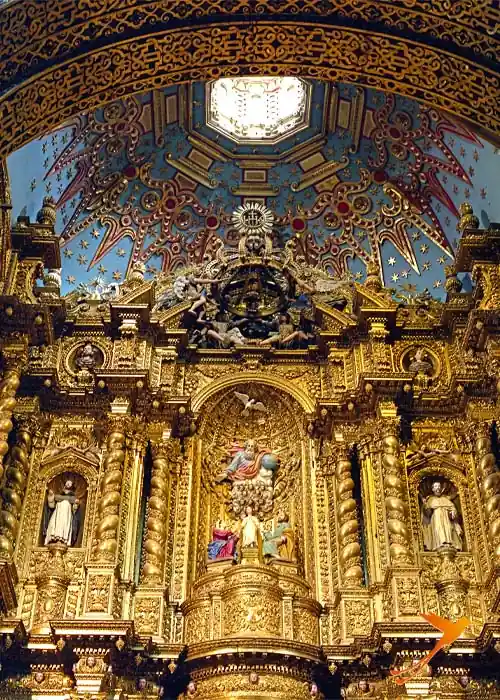
La Compañía de Jesús
Address: Calle García Moreno y Sucre.
Construction: 1605
Observation: It is forbidden to take pictures or videos of its interior.
Visiting hours: M to F 9:30 to 18:00 Saturdays 9:30 to 16:00 Photo of Quito tourism.
Convent and Museum of art of the Church of San Francisco.
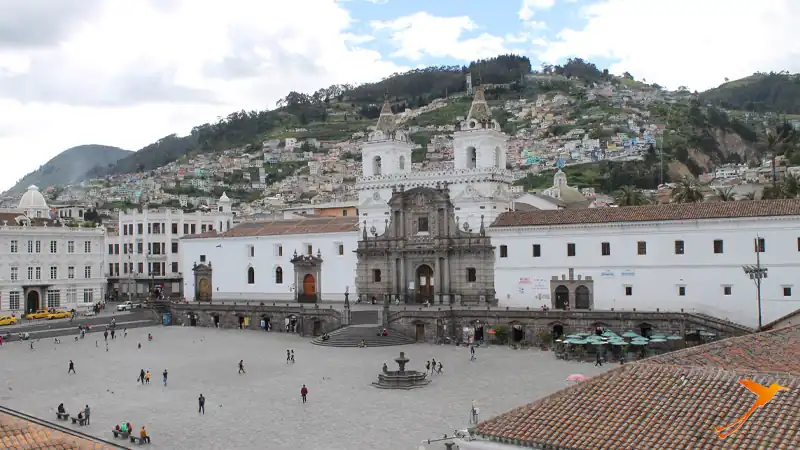
Next we continued our tour by entering the Pedro Gocial art museum which is part of the Franciscan convent. Inside: the courtyard with its gardens, the stone floor and in the middle a marble fountain. From there we took the stairs on the left side to enter the Choir, which has wooden seats arranged like tribunes where they used to pray and sing. There are two wind organs and in the middle the Facistol (wooden furniture, movable, with 4 sides) which in ancient times was used to accent the books with the notes and lyrics of the songs; the same that we saw in the art museum. In addition, there is an impressive crucifix and from here you have an impressive view of the temple.
After leaving the choir, we took a narrow path to the right and stairs through a tunnel that lead us to the bell tower. Once up you can walk from one tower to another. It has a spectacular 360° view of the entire historic center and from this height you can really see how big this convent is.
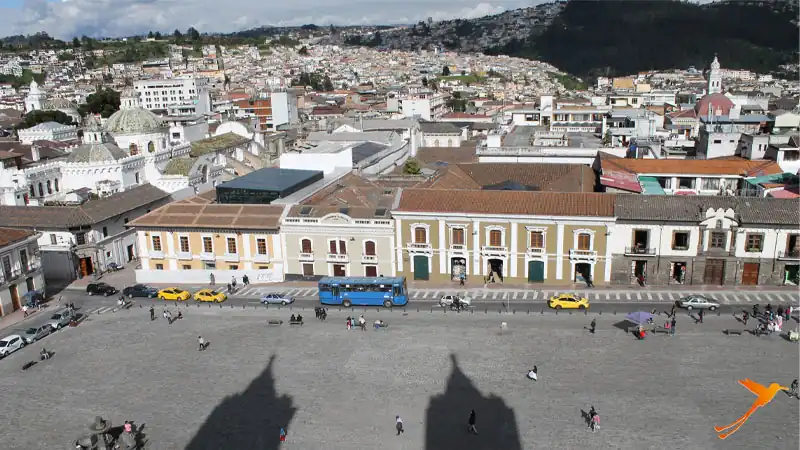
Finally we visited what used to be the cloister of services and the brewery. Here was the first bakery of the city. Personally I recommend visiting the historic center of Quito during the holy week since the catacombs will be open to the public.
The church of San Francisco is one of the oldest churches in Quito. In its beginning the height of its two towers were higher compared to the same that we can see nowadays. This convent has 7 cloisters. The San Andrés school-workshop was also operating here. A total of three temples were built: San Francisco, Cantuña and Buenaventura. The full Spanish name of the city comes from here “San Francisco de Quito”. It is undoubtedly one of the places to visit in Quito.
Convent and Museum of art of the Church of San Francisco.
Address: Calle Cuenca 477
Construction: 1535
Visiting hours: M to F 10:00 to 14:00 and 15:00 to 16:30, Saturdays 10:00 to 14:00
visit our other channels
Recent Posts
- From Manglaralto to Pacoche and surroundings April 18, 2024
- Excursions within the rainforest region of Ecuador April 5, 2024
- Ecuador in a state of emergency?! My personal experience March 22, 2024
- The 10 most beautiful lakes and lagoons in Ecuador – Part 2 March 12, 2024
- The 10 most beautiful lakes and lagoons in Ecuador – Part 1 February 23, 2024